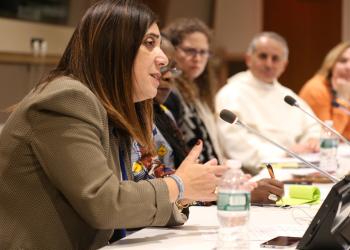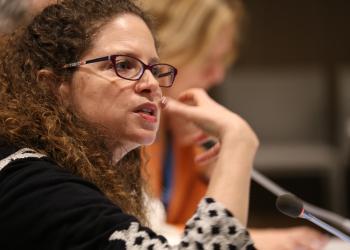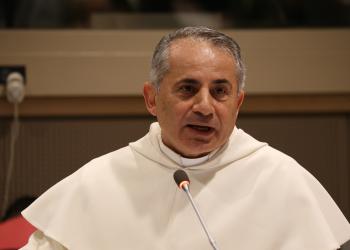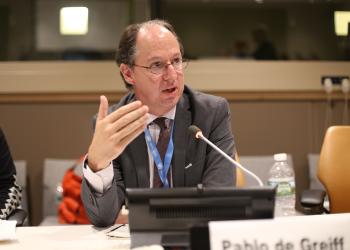The relationship between cultural heritage and human rights explored at the UN
Do 2500-year-old statues and ancient religious manuscripts deserve protection within the international human rights framework?
The answer is yes, according to a panel of experts at a United Nations event convened to discuss how the destruction of items of significant cultural heritage – such as Buddhist statues in Afghanistan, ancient monuments and manuscripts in Iraq, Native American burial grounds, and historic Baha'i cemeteries in Iran – impacts human beings and their rights.
“Cultural heritage is a human rights issue, and that the destruction of cultural heritage harms a range of human rights, such as the right to freedom of thought and religion, the right to freedom of expression, including the right to learning about your history and the history of others,” said Karima Bennoune, the UN Special Rapporteur in the field of cultural rights, who convened the meeting.
Held 27 October 2016, the event also featured the participation of Pablo de Greiff, the Special Rapporteur on the promotion of truth, justice, reparation and guarantees of non‐recurrence; Father Najeeb Michael, Director of the Research Dominican Center, Erbil, Iraq; Diane Ala’i, a representative of the Baha’i International Community to the United Nations in Geneva; and Kristen Carpenter of the Oneida Indian Nation, a Visiting Professor of Law at Harvard.
Ms. Bennoune said acts that destroy cultural heritage, such as the destruction of the 2500-year-old Buddhist statues by the Taliban in Bamiyan, are not “just property crimes.”
“They are crimes aimed at things that people hold dear, crimes which are aimed at harming human beings,” she said.
In her report, for example, Ms. Bennoune noted that there are deep interconnections between sites of cultural heritage and religious practices, and, hence, such destruction impinges on freedom of religion.
Father Michael described his efforts to rescue ancient manuscripts from ISIS in Iraq, and why he viewed it as a protection of human rights.
“My vocation is to protect human lives, and at the same time, my own heritage,” said Father Michael. “Because it is not easy to save the human being without his heritage.
“As you know, Iraq was the site for the Mesopotamian civilization. It is a very old civilization. They invented writing. So when I hold a parchment in my hand that is over one thousand years old, I feel I should protect it, and defend our rights,” he said.
Ms. Ala’i spoke about an assault on cultural heritage undertaken by a state actor – the attacks on Baha'i holy places and cemeteries in Iran.
She noted that the Baha'i Faith originated in Iran, and therefore many of its most historic sites are located there, as are cemeteries where generations of Baha’is lay at rest.
The government, however, has explicitly – according to a once secret 1991 memorandum signed by Iran’s Supreme Leader, Ali Khamenei – set a policy to destroy the “cultural roots” of the Baha'i Faith, she said.
“It is basically trying to make the community disappear, to not be relevant anymore,” said Ms. Ala’i.
Moreover, she noted, the destruction of important Baha’i holy places, along with government efforts to erase Baha’i history from textbooks, results in the impoverishment of all Iranians, who are thus deprived of important aspects of their own history and culture.
In this context, she contrasted the destruction of cultural heritage by non-state actors like the Taliban and ISIS with those undertaken by a government, like in Iran.
“When you come to a state that destroys on purpose a cultural heritage, it becomes much more horrific, because the government has all the tools of power,” she said.
“On the other hand, states are accountable,” she added, which is why including such destruction in a human rights framework is important.
Mr. de Greiff said that while human rights have traditionally been much more concerned with the safety of individuals, the concept of cultural heritage in a human rights connection could be linked to a broader concept of human dignity.
“The notion of human dignity is inextricably linked with the possibility of finding meaning in our lives,” he said, adding that cultural heritage in some respects traces and records our common effort to find the meaning of existence.
“An attack on culture is an attack on the very possibility of finding meaning in our existence and therefore is an attack on human dignity.
“So that is one fundamental reasons why I think human rights work ought to be much more worried than it has been up to this point with the cultural dimension of human life,” said Mr. de Greiff.
Ms. Carpenter cited the confiscation and destruction of land and religious sites from the Native Americans as yet another example of how cultural heritage and human rights are linked.
“For Native Americans, cultural heritage is very much a part of the natural landscape,” she said. “And states have often removed indigenous peoples from their lands, which they hold sacred and worship."







